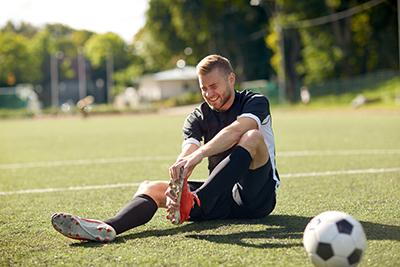Podiatrists play a significant role in addressing sports-related injuries, particularly those affecting the feet, ankles, and lower limbs. Athletes can experience injuries that can impact their performance and overall well-being. Here is some information about four common sports injuries frequently treated by a podiatrist, along with an overview of their potential impact.
1. Fractures
Fractures, or broken bones, are a common occurrence in sports that involve high-impact or sudden movements, such as basketball, soccer, or running. A podiatrist may evaluate fractures in areas like the toes, metatarsals, or heels to determine the severity of the injury. These injuries can vary, ranging from stress fractures, which are small cracks in the bones, to complete fractures caused by direct trauma.
Stress fractures often develop over time due to repetitive stress or overuse. Runners who increase their training intensity too quickly without proper rest may be more susceptible. A podiatrist can help identify and address the injury appropriately. Managing fractures may involve immobilization with a cast or brace or modifying activities under a specialist’s guidance.
2. Dislocations
Dislocations in the feet or ankles can occur when the bones in a joint are forced out of their natural position. These injuries often result from sudden impacts or twisting motions, making them common in sports like football or gymnastics. A podiatrist can assist in diagnosing dislocations and providing appropriate care to restore joint alignment.
Symptoms of a dislocation can include severe pain, visible deformity, and swelling in the affected area. Immediate medical attention is often necessary to address these injuries and prevent further damage. Without prompt treatment, a dislocation can lead to long-term complications, including joint instability and reduced mobility.
Treatment may involve manual manipulation to realign the joint, followed by immobilization or a tailored rehabilitation plan. Collaborating with a podiatrist during recovery may help prevent recurrent dislocations. Early intervention and consistent follow-up care are key to optimal recovery.
3. Tendonitis
Tendonitis is the inflammation of a tendon, which connects muscles to bones. Athletes who repeatedly run or jump may develop tendonitis in areas like the Achilles tendon or foot and ankle tendons. Common symptoms include pain, stiffness, and discomfort during activity. A podiatrist can assess the area and suggest ways to reduce inflammation and aid recovery. Treatment may involve rest, ice, orthotics, and exercises to build strength and flexibility. To prevent tendonitis, focus on maintaining proper form, warming up adequately, and increasing activity gradually.
4. Plantar Fasciitis
Plantar fasciitis is a common condition caused by inflammation of the plantar fascia. This is a thick band of tissue along the bottom of the foot. Athletes, such as runners or dancers, are often more prone to developing this condition. They spend a significant amount of time on their feet.
Factors like sudden increases in physical activity, improper footwear, or structural issues like flat feet can contribute to its onset. The condition typically presents as sharp heel pain. This pain is often worse in the mornings or after extended activity.
Managing plantar fasciitis often involves stretching exercises, footwear modifications, orthotic inserts, or physical therapy. Podiatrists may evaluate the condition by examining the patient’s activity history and foot structure. Early treatment is key to relieving discomfort and preventing the condition from worsening.
Stay Active and Healthy with Podiatrist Care
Sports injuries affecting the feet and ankles are common, but they don’t have to sideline athletes for long. Podiatrists provide valuable expertise in diagnosing and managing these injuries Taking proactive steps to address sports-related injuries can support long-term mobility and keep you performing at your best.

